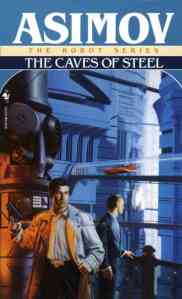 Science fiction from 1954 is a hoot!
Science fiction from 1954 is a hoot!
Recently I finished The Caves of Steel by Isaac Asimov. In a nutshell it’s a buddy cop story. To be specific, it’s a buddy cop story where one cop is a technophobe and the other cop is a robot. They’re forced to put up with each other in order to catch a killer (and it’s a foregone conclusion that they wind up friends). This might sound like a cliché, but as far as I know, Isaac Asimov was the first writer to try it.
The real fun of this story is how unintentionally amusing the New York City of the future is. It’s the year 2500 or so and Earth’s population has risen to a ghastly eight billion people. All of Earth’s land area has been turned over to cellulose farms* and the world’s human beings squeeze into steel-enclosed cities that look like crosses between Tokyo and Calcutta. The state controls all aspects of peoples’ lives, from where they can live and what food rations they can get to how many children couples are allowed to have. Yet curiously, the state fails to follow through with any form of mandatory birth control (probably because the birth control pill didn’t hit the market until six years after this book was published).
This high-tech New York is filled with millions of nuclear families that look like they walked straight out of Leave it to Beaver. Women primarily work as wives and mothers because they’re too airheaded to do anything else. Where’s Susan Calvin when you need her?
There’s all sorts of little incongruities, too. Eyeglasses drop when you break them because they’re made out of actual glass. Newspapers still exist and they’re still made out of paper, too. The police department’s most advanced computer takes two hours to search its database and the characters marvel at its speed. And yet the robot cop’s brain is so sophisticated that he regularly passes the Turing test, except when you try to talk to him about emotions. Also he’s atomic powered. Not nuclear power, atomic power.
At least there’s one familiar-looking technology in this book. The “trimensic projection” that the characters go on about so much is clearly Skype.
I’m not trying to make fun of Isaac Asimov for this book. Asimov was brilliant. But this book just goes to show that one of the smartest men alive in 1954 can get the future so wrong. It makes me wonder what we’re going to get wrong about our projections of the future.
.
.
* The cellulose gets hydrolyzed to sugar, which then gets fed to yeast. The yeast have been genetically engineered to produce all the organic molecules we need to eat. This is in fact a really cool idea.
